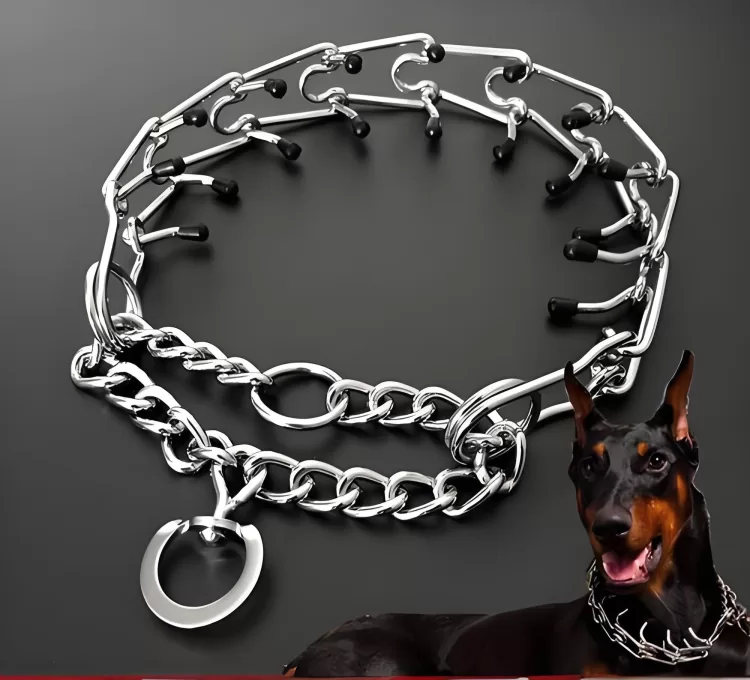
Training a dog requires patience, consistency, and the right tools. Among the most debated tools in dog training is the pinch collar (also called a prong collar). When used correctly, it can be an effective way to communicate with strong or stubborn dogs. However, misuse can lead to fear, injury, or mistrust. This guide will walk you through how to use a pinch collar safely, ethically, and effectively, while addressing common concerns and alternatives.
What Is a Pinch Collar?
A pinch collar is a metal chain collar with interlocking prongs that apply pressure around a dog’s neck when pulled. Unlike choke chains, pinch collars distribute pressure evenly, mimicking the corrective nips a mother dog might use to discipline her puppies. When fitted and used properly, it’s designed to deliver a quick, clear signal—not pain—to redirect unwanted behavior.
Key Features:
- Adjustable metal links.
- Blunt, rounded prongs (never sharp).
- Quick-release buckle for safety.
When Should You Consider a Pinch Collar?
Pinch collars are not a first-choice tool for basic obedience. They’re typically used for:
- Large, strong breeds (e.g., German Shepherds, Huskies) that pull excessively on walks.
- Reactive dogs that lunge at triggers (other dogs, cars, etc.).
- Advanced training for working dogs (e.g., police or service dogs).
Important: Never use a pinch collar on puppies, timid dogs, or dogs with respiratory issues. Always consult a professional trainer before introducing one.
Step-by-Step Guide to Using a Pinch Collar Safely
1. Choose the Right Size and Fit
A poorly fitted pinch collar can cause injury. Follow these steps:
- Measure your dog’s neck and add 2 inches. The collar should sit high on the neck, just below the ears.
- Links should lie flat against the skin without digging in.
- Test the fit: Slide two fingers between the collar and your dog’s neck. If it’s too tight or loose, adjust the links.
Pro Tip: Opt for a Herm Sprenger brand collar—they’re made with rounded, polished prongs to minimize discomfort.
2. Introduce the Collar Gradually
Dogs need to associate the collar with positive experiences:
- Let them sniff the collar.
- Reward calm behavior with treats while putting it on.
- Practice short, low-stress sessions indoors before using it on walks.
Never leave a pinch collar on unsupervised—it’s not a replacement for a flat collar or harness.
3. Master the “Pop and Release” Technique
The goal is to use quick, gentle corrections—not constant pressure:
- Hold the leash loosely; let the collar rest naturally.
- When your dog pulls or misbehaves, give a short, upward “pop” (like a tap on the shoulder) followed by immediate release.
- Praise or reward as soon as they respond (e.g., stopping a pull or sitting calmly).
Common Mistake: Jerking the leash sideways or holding tension. This can injure the trachea or confuse the dog.
4. Pair with Positive Reinforcement
A pinch collar is only effective when combined with rewards. For example:
- If your dog stops pulling after a correction, say “Yes!” and offer a treat.
- Use verbal cues like “heel” or “easy” to reinforce desired behavior.
Warning: Avoid using the collar for punishment. It’s a communication tool, not a way to vent frustration.
5. Know When to Remove It
Once your dog reliably obeys commands, transition back to a flat collar or harness. Pinch collars are meant for training phases, not lifelong use.
Common Mistakes to Avoid
- Using the collar as a “quick fix”: Training requires consistency.
- Incorrect positioning: A low-hanging collar puts pressure on the trachea.
- Over-correction: Excessive force can cause physical or emotional harm.
- Using it without guidance: Always work with a certified trainer.
Ethical Concerns and Alternatives
Pinch collars are controversial. Critics argue they can cause pain, anxiety, or aggression. Before using one, consider these alternatives:
- Front-clip harnesses (e.g., EasyWalk): Redirects pulling by turning the dog sideways.
- Head halters (e.g., Gentle Leader): Controls the head, similar to a horse halter.
- Positive reinforcement training: Reward-based methods using treats, toys, or praise.
When in Doubt: Consult a certified force-free trainer to explore humane options tailored to your dog’s needs.
FAQ: Addressing Your Pinch Collar Questions
Q1: Are pinch collars cruel?
A: When used incorrectly, yes. However, many professional trainers argue that properly timed, gentle corrections are less harmful than constant choking from a flat collar. The key is education and moderation.
Q2: Can pinch collars cause injury?
A: Yes, if misused. Risks include neck wounds, tracheal damage, or increased aggression. Always prioritize fit and technique.
Q3: Are there dogs that should never use a pinch collar?
A: Yes. Avoid them for:
- Puppies under 6 months.
- Brachycephalic breeds (e.g., Pugs, Bulldogs).
- Fearful or abused dogs.
Q4: How long can my dog wear a pinch collar?
A: Only during training sessions or walks. Remove it immediately afterward.
Q5: My dog still pulls with the pinch collar. What now?
A: You may need to adjust your technique, collar fit, or consult a trainer. Some dogs become desensitized if corrections are inconsistent.
Q6: Are there legal restrictions on pinch collars?
A: Some countries (e.g., Australia, parts of Europe) ban prong collars. Check local laws before purchasing.
Final Thoughts: Responsibility First
A pinch collar is a powerful tool that demands respect, knowledge, and empathy. While it can help manage challenging behaviors, it’s not a substitute for building trust and communication with your dog. Always prioritize positive reinforcement, and if you’re unsure, seek guidance from a certified professional.
Remember: The best training tool is a strong bond. Whether you choose a pinch collar, harness, or clicker, your dog’s well-being should always come first.